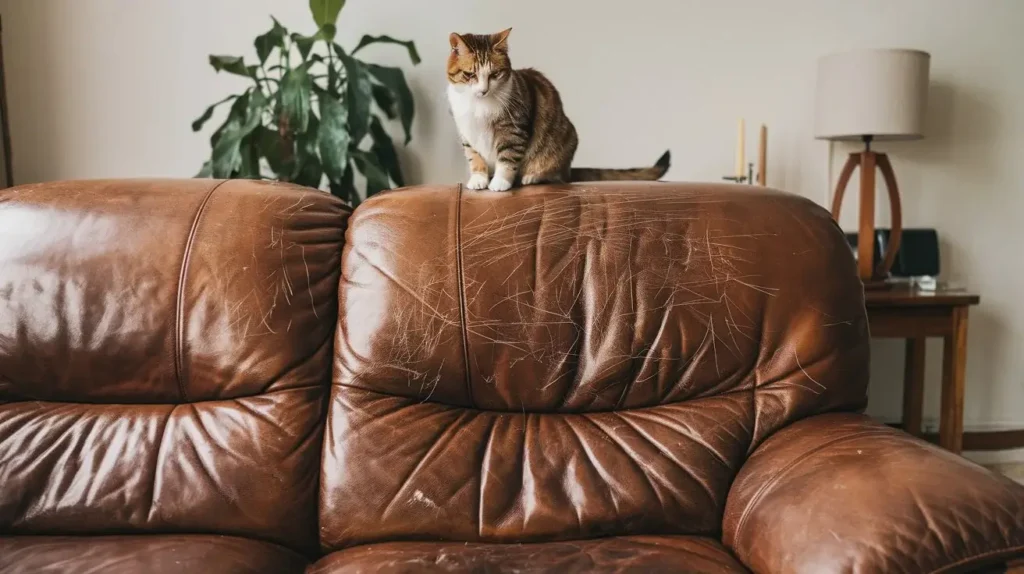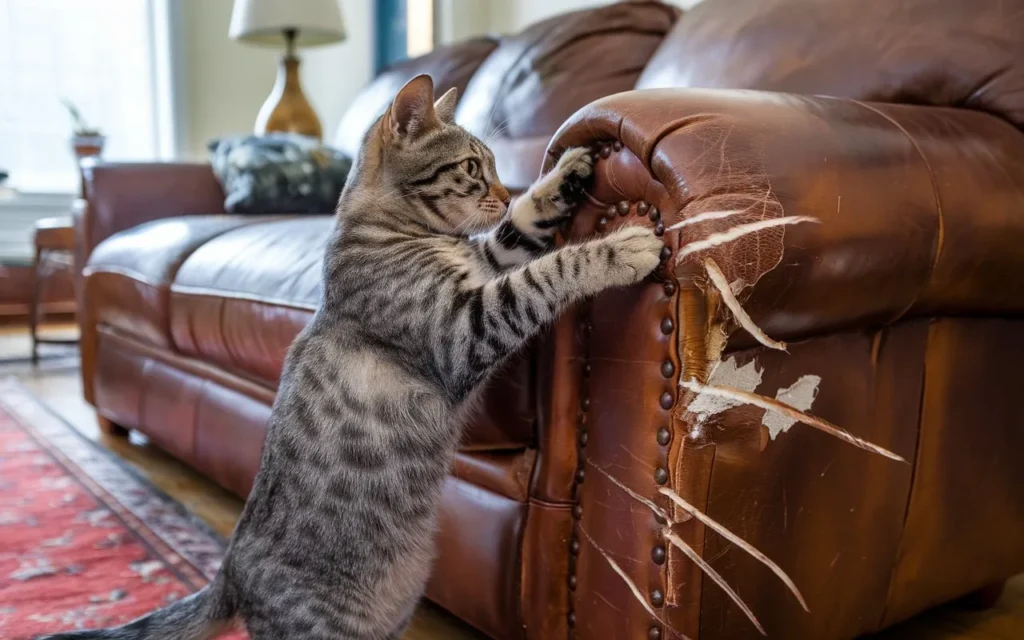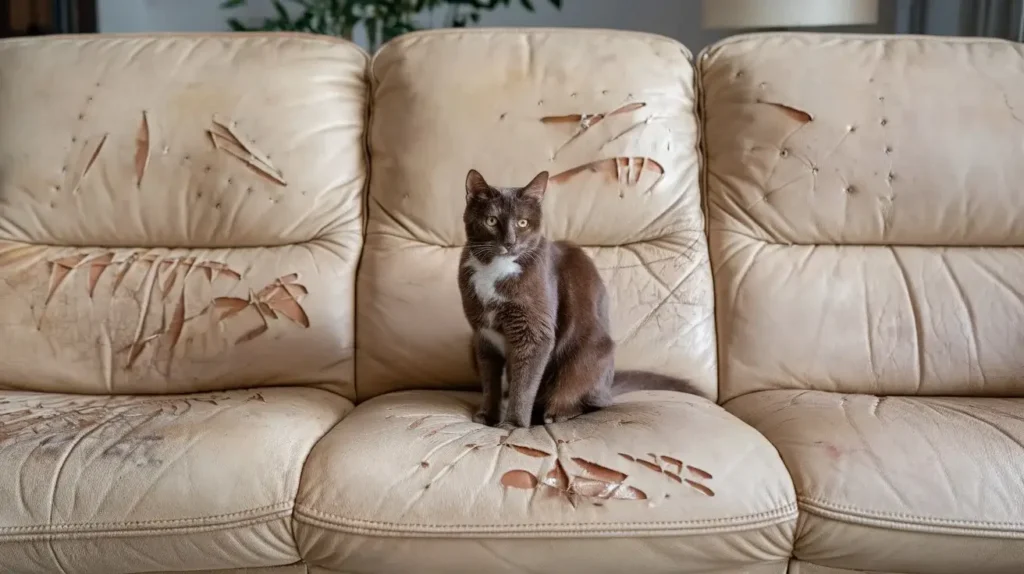introduction : do cats scratch leather?
As a cat owner, you’ve likely asked yourself, “Do cats scratch leather?” In brief, the response is affirmative; they frequently do. Cats are natural scratchers, and leather furniture can be an irresistible target for their claws. However, understanding why cats scratch leather and knowing how to prevent and repair this behavior can help you maintain harmony between your feline friend and your cherished leather furnishings.
Why Do Cats Scratch Leather? Unraveling Feline Behavior
Before we delve into prevention and repair methods, it’s crucial to understand the reasons behind this behavior. Cats scratch for various reasons, and unfortunately, leather often becomes a prime target. So, why do cats scratch leather specifically?
- Texture appeal: Leather’s smooth yet resistant surface provides an appealing scratching sensation for cats.
- Marking territory: When cats scratch leather, they leave both visual and scent marks, signaling to other cats that this is their space.
- Stretching and exercise: The act of scratching allows cats to stretch their muscles and maintain flexibility, with leather furniture often at a convenient height.
- Claw maintenance: Regular scratching helps cats shed old claw sheaths and keep their claws sharp, with leather providing an effective surface for this purpose.
- Stress relief: Scratching can be a way for cats to relieve stress or express excitement, and the durability of leather makes it a satisfying outlet.
Understanding these motivations is key to addressing the question, “Do cats scratch leather?” and finding effective solutions to protect your furniture.
How Do You Keep Cats from Scratching Leather Furniture? Effective Prevention Strategies
Now that we understand why cats scratch leather, let’s explore how to prevent this behavior. Keeping cats from scratching leather furniture involves a multi-faceted approach:
1. Provide Alternative Scratching Surfaces: Give Them a Better Option
One of the most crucial steps in preventing cats from scratching leather furniture is to offer them appropriate alternatives. Since we know cats need to scratch, it’s essential to give them acceptable options:
- Scratching posts: Invest in sturdy, tall scratching posts covered in materials like sisal rope or corrugated cardboard.
- Horizontal scratchers: Some cats prefer scratching horizontally, so provide flat scratching pads or boards.
- Cat trees: Multi-tiered cat trees typically feature a range of scratching materials and function as amusement hubs for your cat.
By placing these alternatives near the leather furniture your cat tends to scratch, you’re providing an easy choice for them when the urge to scratch strikes.
2. Make Leather Furniture Unappealing: Discourage the Behavior
To discourage your cat from scratching leather furniture, you can make it less attractive using various methods:
- Double-sided tape: Apply strips of double-sided tape to areas your cat likes to scratch, as cats dislike the sticky sensation on their paws.
- Aluminum foil: Cover vulnerable areas with aluminum foil, since the texture and sound are usually unappealing to cats.
- Citrus scents: Many cats dislike citrus odors, so use a citrus-scented spray on or around your leather furniture.
- Plastic covers: Temporarily cover your furniture with plastic sheets, as the smooth surface is less appealing for scratching.
3. Use Deterrent Sprays: A Scent-Based Solution
Commercial cat deterrent sprays can be effective in keeping cats away from leather furniture. These sprays often contain scents that cats find unpleasant but are typically unnoticeable to humans. Always test the spray on a small, inconspicuous area first to ensure it doesn’t damage the leather.
4. Trim Your Cat’s Claws Regularly: Minimize Potential Damage
Keeping your cat’s claws trimmed can significantly reduce damage to leather furniture. Clip your cat’s nails every two to three weeks:
- Use cat-specific nail clippers for safety and efficiency.
- Only trim the white tip of the claw, carefully avoiding the pink quick.
- If you’re unsure about the proper technique, ask your veterinarian to demonstrate.
5. Use Soft Paws or Claw Caps: A Physical Barrier
Soft paws or claw caps are vinyl nail covers that can be applied to your cat’s claws. They’re painless, safe, and can effectively prevent scratching damage:
- Choose the appropriate size for your cat to ensure comfort and effectiveness.
- Apply with the included adhesive, following the instructions carefully.
- Replace every 4-6 weeks as they grow out with the natural claw.
6. Positive Reinforcement Training: Teach Good Habits
Training your cat to use appropriate scratching surfaces is a long-term solution to prevent leather scratching:
- When you see your cat using the scratching post, offer immediate praise and treats to reinforce the behavior.
- If you catch your cat scratching leather furniture, gently redirect them to the appropriate surface and reward them when they use it.
- Never punish your cat for scratching, as this can create anxiety and potentially worsen the behavior.

How Do You Stop a Cat from Scratching Leather Furniture? Breaking the Habit
While prevention is ideal, you may need to take action if your cat has already developed a habit of scratching leather furniture. Here are some strategies to stop this behavior:
1. Consistent Redirection: Patience and Persistence
Every time you see your cat approaching the leather furniture with intent to scratch:
- Interrupt the behavior with a firm “No” or a clap to get their attention.
- Immediately guide them to an appropriate scratching surface to redirect their behavior.
- Praise and reward them when they use the correct surface to reinforce positive behavior.
2. Cover the Furniture Temporarily: Out of Sight, Out of Mind
While training your cat to avoid scratching leather, consider covering the furniture:
- Utilize heavy blankets or specially designed furniture covers to safeguard the leather surface.
- Gradually remove the covers as your cat learns to use appropriate scratching surfaces.
3. Use Deterrent Devices: Negative Association
Motion-activated deterrents can help break the habit of scratching leather:
- Spray bottles: Some cats dislike water and will avoid the area after being sprayed.
- Motion-activated air cans: These release a harmless burst of air when the cat approaches the leather furniture.
- Sonic devices: These emit a high-pitched sound unpleasant to cats but inaudible to humans.
4. Environmental Enrichment: A Busy Cat is Less Likely to Scratch Leather
A bored cat is more likely to engage in destructive behavior like scratching leather. Provide plenty of stimulation:
- Engaging toys designed to keep your cat entertained and mentally challenged.
- Puzzle feeders to make mealtime more challenging and interesting.
- Window perches allow for bird watching, offering entertainment and helping to alleviate boredom.
- Regular play sessions with you to strengthen your bond and provide exercise.
5. Address Underlying Issues: Tackle the Root Cause
Sometimes, excessive scratching of leather furniture can be a sign of stress or anxiety. Consider:
- Have there been any recent adjustments in the home that could be contributing to stress?
- New pets or family members that could be disrupting your cat’s routine.
- Changes in your cat’s daily schedule that might be causing anxiety.
Consult with your veterinarian if you suspect underlying issues. They may recommend behavior modification techniques or, in some cases, anti-anxiety medication to help your cat feel more comfortable and less likely to scratch leather furniture.

How Do You Fix Cat Scratches on Leather Furniture? Repair Techniques
Despite your best efforts to prevent cats from scratching leather, damage may still occur. Don’t despair – there are ways to repair cat scratches on leather furniture:
1. Assess the Damage: Determine the Extent of Leather Scratches
Before attempting any repairs, carefully examine the scratches on your leather furniture:
- Superficial scratches: These affect only the surface finish of the leather and are easier to repair.
- Deep scratches: These penetrate the leather and may require professional attention for best results.
2. Clean the Area: Prepare the Leather for Repair
Before repairing cat scratches on leather, clean the scratched area thoroughly:
- Use a leather cleaner or a mixture of warm water and mild soap to remove any dirt or debris.
- Gently clean with a soft cloth, being careful not to further damage the leather.
- Ensure the area is fully dry before continuing with the repairs.
3. Use a Leather Repair Kit: DIY Solution for Minor to Moderate Scratches
For minor to moderate cat scratches on leather furniture, a leather repair kit can be effective:
- Choose a kit that matches your leather color for a seamless repair.
- Adhere closely to the kit’s instructions, which usually include:
- Applying a filler compound to even out the scratch.
- Smoothing the surface to blend with the surrounding leather.
- Applying a colorant to match the leather’s original color.
- Sealing with a finish coat to protect the repair.
4. Try Home Remedies: Solutions for Very Light Scratches
For very light cat scratches on leather, some home remedies might help:
- Olive oil: Gently rub a small amount into the scratch with a soft cloth to help blend it with the surrounding leather.
- Vinegar: Mix equal parts water and vinegar, apply with a soft cloth, and buff dry to minimize the appearance of scratches.
- Leather conditioner: Regular conditioning can help minimize the appearance of light scratches and keep the leather supple.
5. Seek Professional Help: Expert Solutions for Severe Damage
For deep scratches or extensive damage from cat claws, professional repair is often the best option:
- Leather repair specialists have the tools and expertise to match color and texture accurately.
- They can often restore severely damaged leather to a like-new condition, even when cats have scratched leather extensively.
How Do You Repair Cat Scratches on Leather Furniture? Advanced Techniques
When it comes to repairing more significant cat scratches on leather furniture, a more detailed approach is necessary:
1. Leather Filler for Deep Scratches: Repairing the Surface
For scratches that have penetrated the leather:
- Clean the area thoroughly and let it dry completely.
- Apply a leather filler using a small spatula or palette knife, following the product instructions.
- Allow the filler to dry completely (usually 24 hours) to ensure a strong repair.
- Sand the filled area gently with fine-grit sandpaper to smooth it out and blend with the surrounding leather.
- Clean off any dust with a slightly damp cloth before proceeding to the next step.
2. Color Matching: Blending the Repair
Achieving the right color is crucial for an invisible repair of cat scratches on leather:
- Use a leather colorant kit that allows you to mix colors for a perfect match.
- Test the color on an inconspicuous area first to ensure it blends well with your leather.
- Apply thin layers of colorant with a sponge, allowing each layer to dry before adding the next.
- Build up the color gradually until it matches the surrounding leather seamlessly.
3. Texturing: Mimicking the Original Leather Finish
To match the repaired area with the surrounding leather texture:
- Use a leather texturing tool or a textured sponge to recreate the original leather grain.
- Gently press the tool onto the still-slightly-wet colorant to create a texture that matches the rest of the furniture.
- Practice on a scrap piece of leather first to perfect your technique before applying it to your furniture.
4. Sealing the Repair: Protecting Your Work
To protect your repair work and ensure longevity:
- Apply a leather sealant or finish coat according to the product instructions.
- This helps protect the repair and gives it a sheen that matches the rest of the furniture.
- Allow the sealant to dry completely before using the furniture to ensure the best results.
5. Regular Maintenance: Preserving Your Leather Furniture
After repairing cat scratches on leather furniture:
- Apply a leather conditioner regularly to keep the leather supple and resistant to future scratches.
- Clean spills immediately to prevent staining and maintain the leather’s appearance.
- Keep the leather out of direct sunlight to prevent fading and drying, which can make it more susceptible to cat scratches.

Preventing Future Damage: A Comprehensive Approach to Protect Leather from Cat Scratches
While knowing how to repair cat scratches on leather furniture is valuable, preventing future damage is even more crucial. Let’s delve deeper into some advanced prevention strategies to keep your cats from scratching leather:
1. Understanding Your Cat’s Scratching Preferences: Know Your Feline
Cats have individual preferences when it comes to scratching, which can help you protect your leather furniture:
- Observe your cat’s scratching behavior: Do they prefer vertical or horizontal surfaces?
- Notice the textures they’re drawn to: Rough, smooth, or something in between?
- Pay attention to the locations they choose: Near sleeping areas, by windows, or in high-traffic zones?
Understanding these preferences will help you provide more appealing alternatives to your leather furniture and reduce the likelihood of cats scratching leather.
2. Creating a Cat-Friendly Environment: Redirect the Scratching Instinct
A well-designed cat environment can significantly reduce unwanted scratching of leather furniture:
- Vertical space: Install cat shelves or cat trees to give your feline friend alternative high places to perch and scratch.
- Window access: Provide window perches with scratching surfaces attached, satisfying both the urge to scratch and to watch the outside world.
- Multiple scratching stations: Place various types of scratchers throughout your home, especially in areas where your cat spends the most time.
By providing these alternatives, you can reduce the appeal of leather furniture as a scratching surface.
3. Pheromone Products: Calm Your Cats and Protect Your Leather from scratch
Feline pheromones can help create a calming environment and reduce stress-related scratching of leather furniture:
- Use plug-in diffusers in rooms with leather furniture to create a soothing atmosphere.
- Apply pheromone sprays to scratching posts to make them more attractive than your leather furniture.
- Consider pheromone collars for cats that seem particularly anxious or prone to excessive scratching of leather.
4. Regular Play Sessions: Tire Out Those Claws
Engaging your cat in regular play can help reduce the urge to scratch leather furniture inappropriately:
- Schedule daily play sessions, especially before meal times, to expend energy.
- Use interactive toys that mimic prey, like wand toys or laser pointers, to satisfy hunting instincts.
- Incorporate scratching posts into playtime to reinforce their use and make them more appealing than leather furniture.
5. Addressing Multi-Cat Household Dynamics: Reduce Competition for Scratching Spots
In homes with multiple cats, scratching can become a territorial issue that may target leather furniture:
- Provide enough resources: Ensure each cat has access to their own scratching posts, litter boxes, and resting areas to reduce competition.
- Create vertical territory: Multiple levels of cat furniture can help reduce competition for space and decrease the appeal of leather furniture as a scratching surface.
- Use pheromone products designed for multi-cat households to promote harmony and reduce stress-related scratching.
6. Consulting with a Feline Behaviorist: Expert Help for Persistent Problems
If scratching problems persist despite your best efforts to protect your leather furniture:
- Consider consulting a certified feline behaviorist for personalized advice.
- They can provide tailored strategies based on your specific situation and your cat’s individual needs.
- A behaviorist can help identify any underlying issues that might be contributing to excessive scratching behavior targeting your leather furniture.
Conclusion: why do cats scratch leather ?
Living with cats and maintaining beautiful leather furniture doesn’t have to be mutually exclusive. By understanding why cats scratch leather, implementing effective prevention strategies, and knowing how to repair damage when it occurs, you can create a harmonious environment for both your feline friends and your cherished furnishings.
Remember, patience and consistency are key when dealing with cats and leather furniture. It may take time for your cat to adjust to new scratching habits, but with perseverance and positive reinforcement, you can successfully redirect their natural scratching behavior away from your leather furniture.
By providing appropriate alternatives, making your leather furniture less appealing, and addressing your cat’s physical and emotional needs, you’re not just protecting your furniture – you’re enhancing








